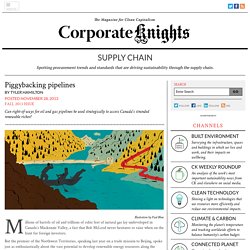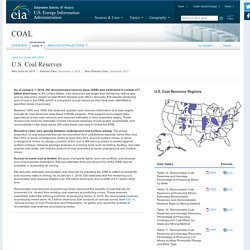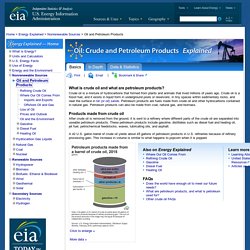

Texas oil company asks Idaho officials to use "integration" to overrule landowners. The Dirty Fight Over Canadian Tar Sands Oil. Oilfield Services To See Spending Surge In 2017. Quick Take: 2017 Oilfield Service and Drilling Outlook from Bloomberg Intelligence Bloomberg Intelligence (BI) analysts Andrew Cosgrove and William Foiles presented a briefing on Wednesday on the outlook for U.S. oil services and drilling.

The bottom line: U.S. shale developers will lead a rebound in oilfield service activity in 2017. Oil Price and CapEx Outlook The Bloomberg analysts expect the global oil market to tighten throughout next year, with demand expected to catch up with supply and inventories being gradually drawn down. But higher OPEC and U.S. production could increase the risk of surplus in 2018.
API Reports A Major Crude Oil Draw. The American Petroleum Institute (API) has reported a sizable draw on U.S. crude oil inventories, down 7.4 million barrels over the previous week—a much larger draw that expected, and the fifth draw in seven weeks.

Analysts expected a draw of around 1.7-2.2 million barrels for the week, and right ahead of the API data dump, oil prices responded upwards nearly 2 percent, in anticipation of a draw on a smaller scale. Last week, the Energy Information Administration (EIA) showed a build of 4.25 million barrels of crude. This week’s 7.4-million-barrel draw is the biggest draw since September. It’s not all good news, though. On the flip side of this, gasoline and distillates experienced massive stockpile builds—the biggest in a year. Gasoline saw a 4.25-million build, against an expected build of only 1 million barrels. Piggybacking pipelines. Millions of barrels of oil and trillions of cubic feet of natural gas lay undeveloped in Canada’s Mackenzie Valley, a fact that Bob McLeod never hesitates to raise when on the hunt for foreign investors.

But the premier of the Northwest Territories, speaking last year on a trade mission to Beijing, spoke just as enthusiastically about the vast potential to develop renewable energy resources along the same Mackenzie River system. “The Mackenzie has some of the best undeveloped hydroelectric resources in North America … clean energy that would supply a hungry market to the south of us,” McLeod told Chinese investors. “It would be a long-term investment with significant upfront capital costs,” he added, but “50 to 100 or more years of low operating and maintenance costs will provide an excellent return on investment.”
Alberta to increase in- situ oilsands monitoring after study finds contaminants. The Alberta government says it will increase environmental monitoring of in-situ oilsands plants following research that shows they can release contaminants into the land and water.

A study released today shows that bitumen extraction using injected steam rather than open-pit mining released low levels of toxins into a small lake near an in-situ site near Cold Lake, Alta. Bill Donahue of Alberta Environment says that’s enough to step up monitoring of all in-situ plants, which now produce more than half of Alberta’s bitumen.
To Congress: Effects of Diluted Bitumen (Tar Sand) on Pipelines - Transportation Research Board Special Report (pdf) Diluted Bitumen Information. A Study of Fate and Behaviour of Diluted Bitumen Oils on Marine Waters December 16, 2013 This document is a final report for a series of physical and chemical tests that were conducted on the fate and behaviour of diluted bitumen oils at a test facility in Gainford, Alberta.

Additionally, as part of this study, a series of tests were conducted to determine the efficiency of various types of oil spill response equipment under similar conditions. Download. 08.21.14 Oil & Gas Transportation: Additional Actions Are Needed to Improve Pipeline Safety. What GAO Found Increased oil and gas production presents challenges for transportation infrastructure because some of this increase is in areas with limited transportation linkages.

For example, insufficient pipeline capacity to transport crude oil has resulted in the increased use of rail, truck, and barge to move oil to refineries, according to government and industry studies and publications GAO reviewed. These transportation limitations and related effects could pose environmental risks and have economic implications. For instance, natural gas produced as a byproduct of oil is burned—a process called flaring—by operators due, in part, to insufficient pipelines in production areas. In a 2012 report, GAO found that flaring poses a risk to air quality as it emits carbon dioxide, a greenhouse gas linked to climate change, and other air pollutants. Crude oil carloads moved by rail in 2012 increased by 24 times over that moved in 2008.
Unconventional Oil and Gas Development: Key Environmental and Public Health Requirements. U.S. Coal Reserves. As of January 1, 2016, the demonstrated reserve base (DRB) was estimated to contain 477 billion short tons.

In the United States, coal resources are larger than remaining natural gas and oil resources, based on total British thermal units (Btus). Annually, EIA reports remaining tons of coal in the DRB, which is comprised of coal resources that have been identified to specified levels of accuracy. Between 1990 and 1999, EIA obtained updated coal reserves information and data largely through its Coal Reserves Data Base (CRDB) program. That program encouraged state agencies to revise coal resource and reserves estimates in their respective states. These revised coal reserves estimates include improved analyses of coal quality, accessibility, and recoverability in the study areas. Recovery rates vary greatly between underground and surface mining. Access to some coal is limited.
Oil: Crude and Petroleum Products. What is crude oil and what are petroleum products?

Crude oil is a mixture of hydrocarbons that formed from plants and animals that lived millions of years ago. Crude oil is a fossil fuel, and it exists in liquid form in underground pools or reservoirs, in tiny spaces within sedimentary rocks, and near the surface in tar (or oil) sands. Petroleum products are fuels made from crude oil and other hydrocarbons contained in natural gas. Petroleum products can also be made from coal, natural gas, and biomass. Products made from crude oil. Fossil fuel emissions have almost stalled. For the third year in a row, global carbon dioxide emissions from fossil fuels and industry have barely grown, while the global economy has continued to grow strongly.

This level of decoupling of carbon emissions from global economic growth is unprecedented. Global CO₂ emissions from the combustion of fossil fuels and industry (including cement production) were 36.3 billion tonnes in 2015, the same as in 2014, and are projected to rise by only 0.2 per cent in 2016 to reach 36.4 billion tonnes. This is a remarkable departure from emissions growth rates of 2.3 per cent for the previous decade, and more than 3 per cent during the 2000s.
Given this good news, we have an extraordinary opportunity to extend the changes that have driven the slowdown and spark the great decline in emissions needed to stabilise the world’s climate. Fossil fuel and industry emissions The slowdown in emissions growth has been primarily driven by China. The carbon quota. A rewards program for the oil sands. It’s been nearly a year since Alberta Premier Rachel Notley announced an ambitious set of policies to cap oil sands emissions, phase out coal-fired power generation and implement an economy-wide carbon tax in Canada’s “dirty” province.

Since revealed last November, Alberta’s climate plan has received widespread praise, including kudos from U.S. President Barack Obama during an historic speech this June in the House of Commons. It has also been embraced by some of the province’s biggest oil sands producers. Alberta working to ease the transition away from coal. EDMONTON, Alberta, Sept. 23 (UPI) -- The provincial government of Alberta said it formed a panel of experts to help address some of the challenges in shifting to a low-carbon economy.
A three-member panel of experts will work on behalf of Alberta's government to discuss challenges faced by those impacted by the retirement of coal-fired power plants and the mining operations associated with them. "We want to see a fair transition that responds to the needs of workers as Alberta transitions to cleaner sources of electricity generation, including ending harmful coal emissions," Economic Development Minister Deron Bilous said in a statement. According to the provincial overview of its energy portfolio, coal offers twice the energy potential of other non-renewable resources. Fuel too toxic for Europe sold to Africa’
European companies are accused of taking advantage of weak fuel standards in African countries to export highly-polluted fuel to West Africa, a new report says. The report, from the Swiss watchdog group of Public Eye, said major European oil companies and commodity traders take crude oil from African countries, blend it with highly-polluted additives, and then sell it back to them.
“Many West African countries that export high grade crude oil to Europe receive toxic low quality fuel in return,” it wrote. Toxic products that the companies add to make the so-called “African Quality” fuels are far higher than those allowed in Europe, according to Public Eye. 2017-2022 OCS Oil and Gas Leasing Program. As required by the OCS Lands Act, a new Program—to cover the years 2017-2022—is under development. The first step in the development process, a Request for Information (RFI), was published in the Federal Register on June 16, 2014, with a 45-day comment period that was extended by 15 days and closed on August 15, 2014. The Draft Proposed Program (DPP), was the first proposal in the staged preparation process of the new Program. The DPP was published on January 29, 2015, with a 60-day comment period that closed on March 30, 2015. On March 15, 2016, the second proposal, the Proposed Program (PP), was published with a 90-day comment period that closed on June 1, 2016.
On November 18, 2016, the final proposal, the Proposed Final Program (PFP), was published. The Climate Deception Dossiers: Internal Fossil Fuel Industry Memos Reveal Decades of Corporate Disinformation.
World Petroleum Assessment - Homepage: USGS, Energy Resources Program. Polish gas company fights for nation's independence from Russia. PARADOX BASIN. Heavy Oil & Sands Guidebook Vol11 2016 TS. Fracking the Future - How Unconventional Gas Threatens our Water, Health and Climate. Unconventional gas drilling is emerging as one of the most controversial energy & environmental issues in the United States and around the world today. Shell to Test Capturing of Carbon in Canada. Associated PressAn oil sands mining operation near Fort McMurray, Alberta. 'Virtually unregulated': Radioactive fracking-waste rules in the US slammed in report.
States involved in the fracking boom employ a patchwork of laws to deal with radioactive drilling waste, according to a new report. Oil and Gas; Hydraulic Fracturing on Federal and Indian Lands. Campaigners Tell Barclays, ‘You Frack My Home, We’ll Move Into Yours’ Despite fracking’s popularity being at an all time low, companies are still pouring money into the controversial practice. Some of the once shadowy companies are now becoming familiar names.
Cuadrilla is probably the best known, having recently had its plans for shale gas development in Lancashire forced through by an ever-willing government. Secretary Jewell Announces Decision to Protect 75,000 Acres of Eastern Tennessee Mountains From Future Surface Mining. Secretary Jewell Announces Offshore Oil and Gas Leasing Plan for 2017-2022. Date: November 18, 2016 Contacts: Jessica Kershaw, interior_press@ios.doi.govConnie Gillette, connie.gillette@boem.gov. Secretary Jewell Announces Resolution of Oil & Gas Leasing Issues in Colorado’s White River National Forest.
Interior Department Releases Second Annual Report of the U.S. Extractive Industries Transparency Initiative. North Dakota pipeline shut down after spill - Energy Transfer Partners, L.P. (NYSE:ETP) Oklahoma quake triggers closing of disposal wells. Delineation of brine contamination in and near the East Poplar oil field, Fort Peck Indian Reservation, northeastern Montana, 2004-09. Environmental Integrity EPA Agrees to Re-Examine Smog-Forming Air Pollution from Drilling Flares. Environmental Integrity Toxic Wastewater from Coal Plants. Shift the Subsidies: Tracking the Flow of Public Money to the Fossil Fuel Industry. Fighting a mid-Atlantic pipeline in the age of Trump. Another Side to the Story: A Look at Colorado’s Ballot Fight. UPDATED: Range Resources Says it has Military Psych Ops Specialists on Staff in PA - Canon, PA Patch. ENBRIDGE Whistleblower. Advocates Fight Oil Companies on Transparency.
Southwestern Appoints New President & CEO. Increase In O&G Bankruptcy Filings Is Alarming In West. America’s Dangerous Pipelines. Trump's "Contract" promises to lift roadblocks to allow Keystone XL, other pipelines. BP hires private security contractors to guard ‘black water’ Eagle Ford News - Community News & Information - Eagle Ford Oil & Gas Shale.
RefineryReport.org. No slowdown in North Dakota oil pipeline construction, Energy Transfer says.